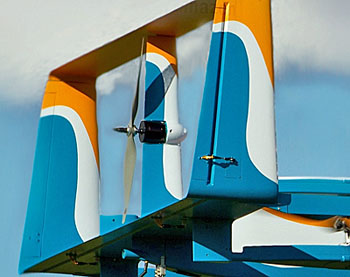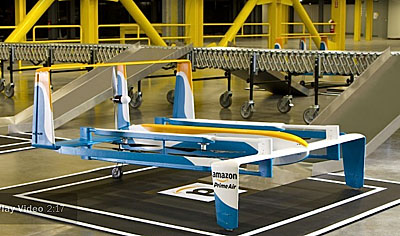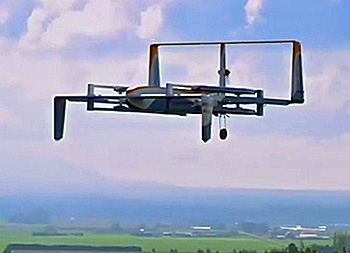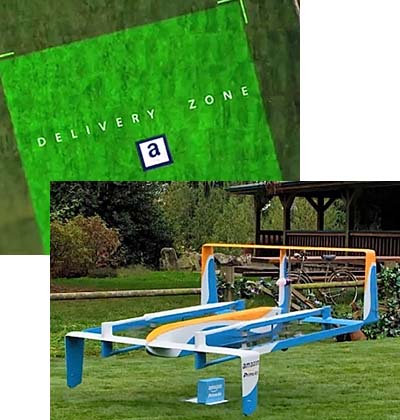
Amazon’s newest drone is part quadcopter, part “conventional” airplane with this prop thrusting most of the flight to your back yard.

Loading the package (autonomously) at the fulfillment center …

… flying en route via more conventional means (Amazon said this an actual in-flight image, not a simulated one) |

… and dropping off your package in your backyard, apparently at a target you’d put out (see video).
I realize that for some readers I may be swimming upstream when I write about drones (or UAVs or RPVs, or whatever). First, many of you simply don’t care; your passion is for manned flight and I completely understand. Second, some of you see real danger to your manned flying due to a growing drone population. Those who guess the future think more than a million units will be sold this holiday season. Third, we have the matter of privacy. Probably like you, I don’t like the idea of some government agency or even a snoopy neighbor being able to peer into my yard against my preference.
This article presents a somewhat different, somewhat nuanced view of drone development and the reasons are financial, which may not be how you’ve seen this issue. Consider that FAA is — compared to most aviation businesses — an absolutely enormous organization. It has an annual budget of more than $15 billion and around 50,000 employees. Very few private airplane makers are bigger. Boeing is, as is Airbus. After that, it drops fast. Cessna’s parent Textron is smaller as is Gulfstream. The vast majority of airframe builders are much, much smaller companies.
The point is that compared to more than 95% of all aviation businesses, FAA is a massive behemoth funded by the American taxpayer. Of course, I know FAA accomplishes many worthy tasks but many feel the regulations they issue interfere as much as help. Many question if those thousands of pages of regulation truly advance safety, the agency’s prime goal.
Into this picture now come some truly mammoth entities. These are private businesses that have many tens of billions in annual sales and the sheer heft to afford armies of lobbyists and lawyers to advance their corporate mission. I don’t portray this as a good thing; in fact, it contributes to cronyism … where government gets cozy with the largest businesses. Nonetheless, when organizations the size of Google or Amazon want to bend FAA their direction, they have the might to achieve far more than your favorite airplane manufacturer.
In the Washington Post today, a story appeared about Amazon’s latest drone design. Part quadcopter and part airplane it has a range of 15 miles, the company claims. They also say it “part of a growing family of drones.” Expect to see lots more about the company’s plans to deliver packages to you via drone. This is not mere speculation or a means to get media attention (though it certainly does that, too).
As with Internet delivery, the so-called “last mile” is the costliest, referring to delivering services or products from a distribution center to your home. So for Amazon, it may truly make sense to bring products to you via drone. Their effort to develop the right flying machine is an ongoing juggernaut that is not likely to stop.
As you may have read, FAA has established a new office to guide drone regulation. I imagine that office will be on the regular beat of Amazon’s lobbyist battalion. In that future, unlike with hundreds of tiny aviation enterprises, FAA will be greeted by people who have deep pockets that even FAA cannot match. Is this going to change the game of drones? You bet!
Their pressure will cause FAA to pay plenty of attention to Amazon and the giant online retailer may achieve many of their goals due to the amount of horsepower they can apply. Your average drone-operating entrepreneur may have to meet a growing list of regs and compliance demands. Those demands can easily be met by Amazon, which can staff a compliance department, but will pose a major impediment for very small businesses.
Online journalist Mary Grady at AVweb included a letter from Tony Dziepak who wrote, “I would register my drone prior to flying it above 200 feet AGL. [However,] I think it is clear from U.S. v. Causby (1946) that the FAA has no authority to regulate “the immediate reaches of the enveloping atmosphere” of my property, which in the Causby case is at least 83 feet AGL. Just as my driveway is not part of the federal highway system, the airspace above my property, at least to my treetops, is not part of the NAS.” I think Tony makes a good point. Is the air above his yard his to control or FAA’s?
My longtime friend and fellow publisher Ben Sclair weighed in the wisdom of drone registration. Being a witty guy he makes a lot of sense when he questions if mere registration can make drone operations safer. You can read his piece here. Alternatively, you can read a non-aviation viewpoint on FAA registration of drones from one of my favorite alternative sources, Reason Magazine here.
As Reason reported, when the Academy of Model Aeronautics (which is represented on the new drone registration task force) examined the FAA data in September 2015, it found that only 3.5% of the agency’s 764 recorded incidents were genuine near misses between drones and manned aircraft. Most of the “incidents” were nothing more than sightings. In any event, AMA reported, “… the most serious incidents in the FAA data — including all actual crashes — involved government military drones, not civilian ones.”
I offer all the preceding as food for thought so you can come to your own opinions about drones. I plan to keep flying mine with the aim of providing you with better content but I’ll be darned careful around any manned aircraft. For the record, here and here are my two earlier articles on drones.
It is not my mission to promote Amazon (though I admit being a regular customer). I merely wish to show their vision of a drone-drenched future. Here’s their YouTube promo video …


Leave a Reply